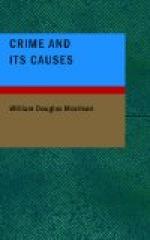CHAPTER III.
THE SEASONS AND CRIME.
Let us now approach the question of temperature and crime from another point of view. International statistics indicate pretty clearly that warm regions exercise an injurious effect on the conduct of European peoples. Does the information furnished by these statistics stand alone, or is it supported by the result of investigations conducted in a different field? To this vital question it will be our endeavour to supply an answer. In the annual reports of the Prison Commissioners there is an instructive diagram showing the mean number of prisoners in the local prisons of England and Wales on the first Tuesday of each month. This diagram has been published for a considerable number of years, and if we take any period of six years it is remarkable to observe the unfailing regularity with which crime begins to decrease as soon as the summer is over and the temperature begins to fall. From the month of October till the month of February in the following year, the prison population continues almost steadily to diminish; from the month of February till the month of October, the same population, allowing for pauses in its progress and occasional deflections in its course, mounts upwards with the rising temperature. According to the last sextennial diagram of the Prison Commissioners, which embraces the six years ended March, 1884, the mean number of prisoners in the local prisons of England and Wales was, on the first Tuesday in February, 17,600; on the first Tuesday in April it had risen to 18,400; on the first Tuesday in July it had reached nearly 19,000; on the first Tuesday in October it culminated in 19,200. From this date onwards the numbers decreased just as steadily as they had previously risen, reaching their lowest point in February, when the upward movement again commenced. The steadiness and regularity of this rise and fall of the prison population, according to the season of the year, goes on with such wonderful precision that it must proceed from the operation of some permanent cause. What is this permanent cause? Is it economic, social, or climatic?
Is it economic? It is sometimes asserted that the increase of crime in the summer months is due to the large number of tramps who leave the workhouses after the winter is over and roam the country in search of employment. Many of these wanderers, it is said, are arrested for vagrancy; in summer they swell the prison population just as they swell the workhouse population in winter. This explanation of the increase of crime in summer contains so many elements of probability, that it has come to be rather widely accepted by students of criminal phenomena. It has not, however, been my good fortune to meet with any facts or statistics of sufficient weight to establish the validity of this explanation. As far as I can ascertain it is an explanation which has obtained




